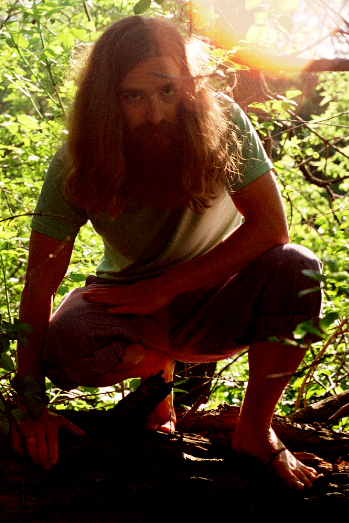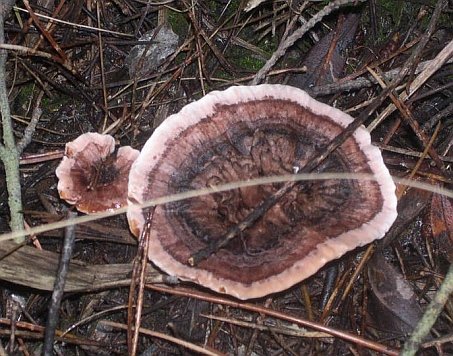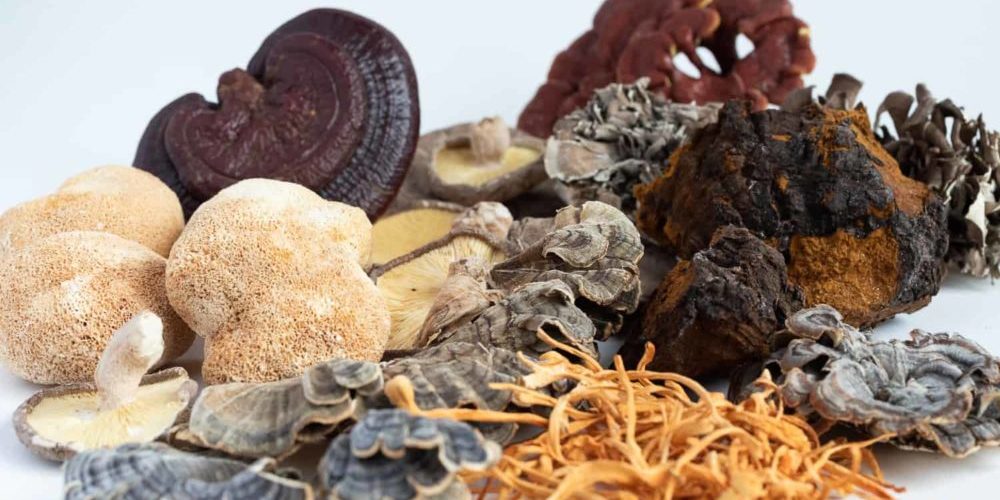Zoned hydnellum, Hydnellum concrescens (Pers.) Banker
Classification
Kingdom Fungi
Phylum Basidiomycota
Class Basidiomycetes
Order Thelephorales
Family Bankeraceae
Genus Hydnellum
Synonyms
Calodon fasciatus (Peck) Pat. [as ‘fasciatum‘]
Calodon zonatus (Batsch) P. Karst.
Hydnellum fasciatum (Peck) Coker & Beers
Hydnellum parvum Banker
Hydnellum queletii (Fr.) P. Karst. [as ‘Queleletii‘]
Hydnellum scrobiculatum f. parvum (Banker) D. Hall & D.E. Stuntz
Hydnellum scrobiculatum var. zonatum (Batsch) K.A. Harrison
Hydnellum subsuccosum K.A. Harrison
Hydnellum velutinum var. zonatum (Batsch) Maas Geest.
Hydnellum vespertilio (Berk.) Banker
Hydnellum zonatum (Batsch) P. Karst.
Hydnellum zonatum f. vespertilio (Berk.) Coker & Beers
Hydnum concrescens Pers.
Hydnum fasciatum Peck
Hydnum queletii Fr.
Hydnum scrobiculatum subsp. zonatum (Batsch) S. Lundell
Hydnum spathulatum Lloyd
Hydnum vespertilio Berk.
Hydnum zonatum Batsch
Phaeodon zonatus (Batsch) J. Schröt.
Common names
Zoned hydnellum
Zoned tooth
Concrescent corky spine fungus
Zontaggsvamp (Swedish)

My name is Austin Collins.
I've dedicated my life to Mushrooms.
I believe Mushrooms are the best kept secret when it comes to health and well being.
For that reason, I would like to share a company with you that in my opinion makes the best mushroom products on the market.
The company is called Noomadic Herbals, my favorite supplement they make is called "Mushroom Total".
I take their products every day and they have helped me think better and have more energy. Give them a try.
-Austin
Description
Fruiting body: single, more often concrescent.
Cap: up to 5 cm broad, plane to depressed, margin evenly to irregularly lobed, tomentose to matted or glabrous, rugulose to rugose, pitted to asperate at disc, white, reddish white to dark brown; yellowish spots of excrement often present on dried sporophores; zonate or with concentric corrugations.
Context: up to 3.5 mm thick, not duplex, slightly zonate, concolorous with cap surface.
Stem: up to 3.3×1.2 cm, central, attenuating upward with a bulbous base, spongy tomentose, matted or glabrous, concolorous, context duplex, zonate, concolorous.
Spines: up to 2 mm long, decurrent, crowded, reddish white to reddish brown or violet brown.
Chemical reactions: context tissue blue green in KOH or NH4OH.
Spores: 6.5 x 4-4.8 µm, subglobose, brownish; tuberculate ornamentation.
Spore deposit: brown.
It is apparently very difficult to distinguish between this species and the morphologically similar H. scrobiculatum. Readers interested in reading how researchers used molecular geneticsto distiniguish between them should check out Parfitt et al., 2007. Due to its fewer appearances in recent years, H. concrescens is a ‘Biodiversity Action Plan’ species in the UK. See this issue of English Nature Research Reports for more details.
Bioactive compounds
A Chinese research paper (Yang et al., 2007) has identified nine known compounds from the fruiting bodies of Hydnellum concrescens, including:
– friedelin
– (22E,24R)-ergosta-5,7,22-trine-3β-ol
– 5α,8α-epidioxy-(22E,24R)-ergosta-6,22-dien-3β-ol
– (22E,24R)-ergosta-5,22-dien-3β-hydroxyl-7-one
– 6-methoxy-cerevisterol
– thelephantin I
– thelephantin J
– thelephantin K
– thelephantin L
Medicinal Properties
Antitumor effects
Polysaccharides extracted from the mycelial culture of H. concrescens and administered intraperitoneally into white mice at a dosage of 300 mg/kg inhibited the growth of Sarcoma 180 and Ehrlich solid cancers by 100% and 90%, respectively (Ohtsuka et al., 1973).
References
Baird RE, Khan SR.
The stipitate hydnums (thelephoraceae) of Florida.
Brittonia. 1986 38(2):171-84.
Ohtsuka S, Ueno S, Yoshikumi C, Hirose F, Ohmura Y, Wada T, Fujii T, Takahashi E.
Polysaccharides having an anticarcinogenic effect and a method of producing them from species of Basidiomycetes.
UK Patent 1331513, 26 September 1973.
Parfitt D, Ainsworth AM, Simpson D, Rogers HJ, Boddy L.
Molecular and morphological discrimination of stipitate hydnoids in the genera Hydnellum and Phellodon.
Mycological Res. 2007 111():761-77.
Yang X-L, Wang F, Shao H-J, Dong Z-J, Ding Z-H, Yang W-Q.
Study on the chemical constituents of Hydnellum concrescens. [Chinese]
Nat Prod Res Dev. 2007




